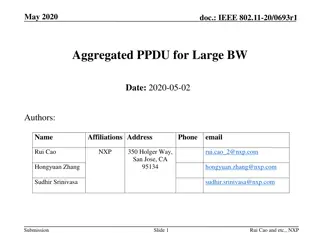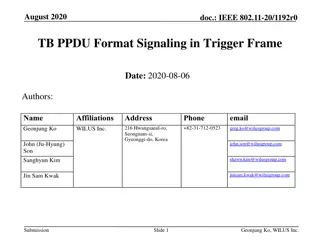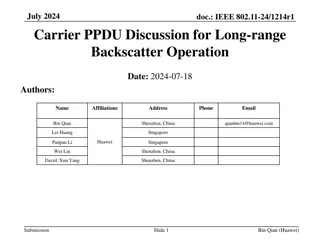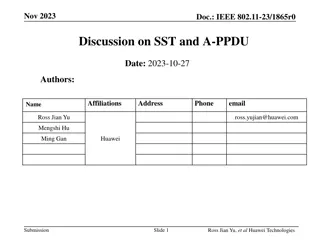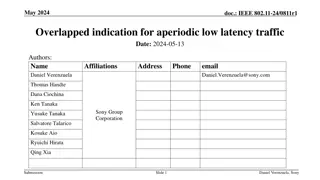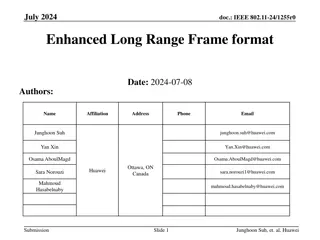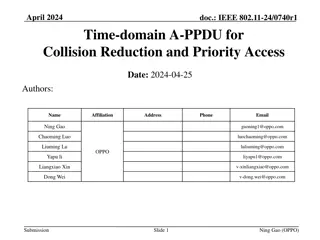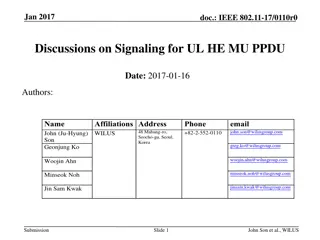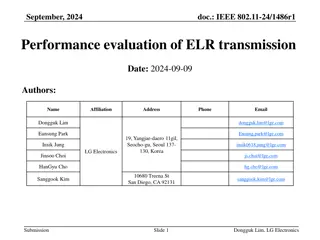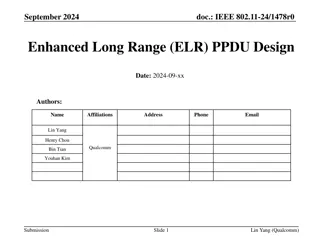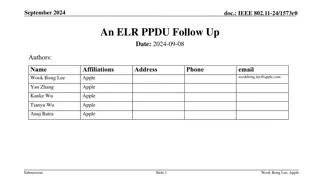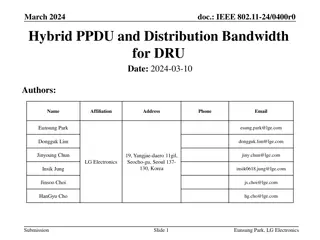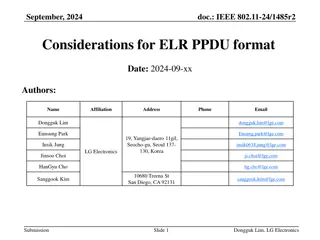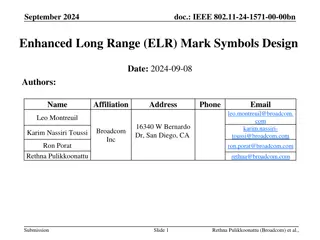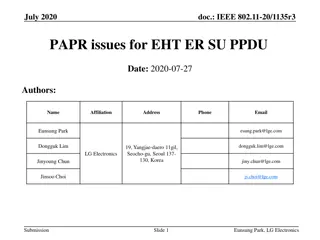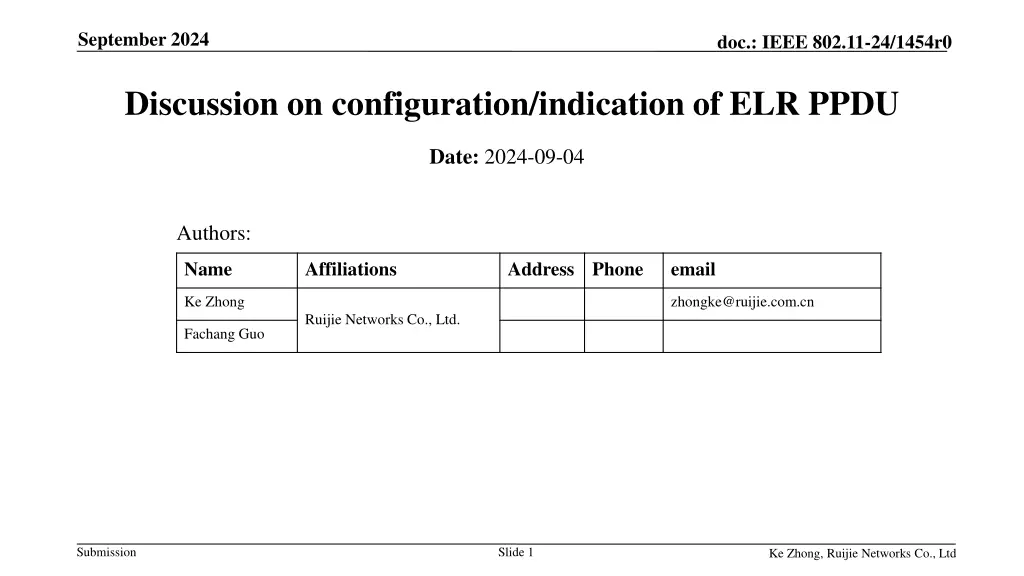
IEEE 802.11-24 Discussion on ELR PPDU Configuration
Explore the discussion on the configuration and indication of Enhanced Long Range (ELR) PPDU in IEEE 802.11-24. Delve into the options for configuring ELR PPDU transmission and reception, including advantages and disadvantages of each approach. Understand the proposals for defining ELR PPDU parameters and structuring within the context of Ultra High Reliability capabilities to enhance wireless communication performance.
Download Presentation

Please find below an Image/Link to download the presentation.
The content on the website is provided AS IS for your information and personal use only. It may not be sold, licensed, or shared on other websites without obtaining consent from the author. If you encounter any issues during the download, it is possible that the publisher has removed the file from their server.
You are allowed to download the files provided on this website for personal or commercial use, subject to the condition that they are used lawfully. All files are the property of their respective owners.
The content on the website is provided AS IS for your information and personal use only. It may not be sold, licensed, or shared on other websites without obtaining consent from the author.
E N D
Presentation Transcript
September 2024 doc.: IEEE 802.11-24/1454r0 Discussion on configuration/indication of ELR PPDU Date: 2024-09-04 Authors: Name Affiliations Address Phone email Ke Zhong zhongke@ruijie.com.cn Ruijie Networks Co., Ltd. Fachang Guo Submission Slide 1 Ke Zhong, Ruijie Networks Co., Ltd
September 2024 doc.: IEEE 802.11-24/1454r0 Abstract Introduction Discussion on configuration/indication of ELR PPDU Conclusion Submission Slide 2 Ke Zhong, Ruijie Networks Co., Ltd
September 2024 doc.: IEEE 802.11-24/1454r0 Introduction In PAR of P802.11bn, the Ultra High Reliability (UHR) capability has been defined to improve Rate-vs-Range enhancement, reduce latency, and reduce power consumption for AP, compared to Extremely High Throughput (EHT) MAC/PHY operation [1]. Enhanced Long Range (ELR) has been investigated in UHR study group since the beginning of 802.11bn and the motion for ELR has been recently passed during the July 2024 Plenary meeting. The detail of the motion is as follows [2]: Move to include the following in the 11bn SFD: Define Enhanced Long Range (ELR) PPDU and potentially other Range Extension mechanisms. Several contributions have been submitted to investigate the design of ELR PPDU including its frame structure, legacy preamble, ELR preamble and ELR data [3]-[6]. In this contribution, the configuration/indication of ELR PPDU is discussed. Submission Slide 3 Ke Zhong, Ruijie Networks Co., Ltd
September 2024 doc.: IEEE 802.11-24/1454r0 Discussion on configuration/indication of ELR PPDU An UHR PPDU is not necessarily an ELR PPDU unless it is indicated and/or configured as ELR PPDU. Option 1: Only configuration AP may configure non-AP STA to transmit or receive ELR PPDU. In this case, non-AP STA may have no information about what ELR PPDU is, just following configuration of AP to transmit or receive whatever PPDU AP configures it to transmit or receive. For example, AP may configure all parameters including e.g., 20MHz BW, single spatial stream, fixed low MCS (e.g., MCS0 or MCS 1) and repeated patterns for time and/or frequency domain and etc., for ELR PPDU transmission or reception. Advantages about Option 1: May not need new signalling/indication to specifically indicate whether it is ELR PPDU or not. May use most of current/legacy configuration with necessary update/change for ELR PPDU. Flexibility in configuring ELR PPDU format. Disadvantages about Option 1: Need to configure every single parameter for each ELR PPDU transmission or reception. May cause huge configuration/signalling effort or overhead if ELR PPDU format is fixed or only has a few alternatives, or most of its parameters are default values (if accepted or decided so). Submission Slide 4 Ke Zhong, Ruijie Networks Co., Ltd
September 2024 doc.: IEEE 802.11-24/1454r0 Discussion on configuration/indication of ELR PPDU An UHR PPDU is not necessarily an ELR PPDU unless it is indicated and/or configured as ELR PPDU. Option 2: Only indication AP may indicate non-AP STA to transmit or receive ELR PPDU. In this case, non-AP STA may have full information about what ELR PPDU is (e.g., only one fixed ELR PPDU format or ELR PPDU format with only a few fixed alternatives). Case 1, only one fixed ELR PPDU format: For example, all parameters/configurations for ELR PPDU transmission or reception including e.g., 20MHz BW, single spatial stream, fixed low MCS (e.g., MCS0 or MCS 1) and repeated patterns for time and/or frequency domain and etc., are known or hardcoded/pre- configured in non-AP STA if agreed so. In other words, all parameters/configurations for ELR PPDU transmission or reception are default parameters/configurations. Case 2, ELR PPDU format with only a few fixed alternatives: For example, ELR PPDU format with only 3 fixed alternatives Alternative 1: Repeated pattern 1 for time and/or frequency domain, while all other parameters are default. Alternative 2: Repeated pattern 2 for time and/or frequency domain, while all other parameters are default. Alternative 3: Repeated pattern 3 for time and/or frequency domain, while all other parameters are default. Advantages about Option 2: Simple signalling/indication to indicate whether it is ELR PPDU (e.g., 1-bit indication) for Case 1, or to indicate ELR PPDU format with only a few fixed alternatives for Case 2 (e.g., 2-bit indication if there are four alternatives). Disadvantages about Option 2: No or only a few flexibility in ELR PPDU format. Submission Slide 5 Ke Zhong, Ruijie Networks Co., Ltd
September 2024 doc.: IEEE 802.11-24/1454r0 Discussion on configuration/indication of ELR PPDU An UHR PPDU is not necessarily an ELR PPDU unless it is indicated and/or configured as ELR PPDU. Option 3: Indication + configuration AP may use both indication + configuration to achieve transmission or reception of ELR PPDU for non- AP STA. In this case, non-AP STA may have partial/most information about ELR PPDU while leaving some scenario-dependent parameters configurable. For example, most parameters/configurations for ELR PPDU transmission or reception including e.g., 20MHz BW, single spatial stream, fixed low MCS (e.g., MCS0 or MCS 1) and etc., are known or hardcoded/pre- configured in non-AP STA if agreed so. In other words, they are default parameters/configurations if indicated as ELR PPDU. However, scenario-dependent parameters, e.g., repeated patterns for time and/or frequency domain etc., are left configurable. Advantages about Option 3: Make a good tradeoff between signalling overhead and flexibility: Reduced signalling effort (compared with Option 1) with more flexibility in configuring a few scenario-dependent parameters (compared with Option 2). Submission Slide 6 Ke Zhong, Ruijie Networks Co., Ltd
September 2024 doc.: IEEE 802.11-24/1454r0 Conclusion Three high-level options are discussed on configuration/indication of ELR PPDU. Among the discussed options, i.e., Option 1 (only configuration), Option 2 (only indication) and Option 3 (indication + configuration), Option 3 (indication + configuration) is preferred, which has reduced signalling effort (compared with Option 1) with more flexibility in configuring a few scenario-dependent parameters (compared with Option 2). More details about Option 3 (indication + configuration) need further study. Details of signalling/indication design (i.e., how to indicate whether it is ELR PPDU). Which parameter(s) in ELR PPDU should be made fixed or hardcoded/pre-configured if indicated as ELR PPDU. Which parameter(s) in ELR PPDU should be made configurable (e.g., scenario-dependent parameters) for each ELR PPDU transmission or reception, and how to configure the parameter(s). Submission Slide 7 Ke Zhong, Ruijie Networks Co., Ltd
September 2024 doc.: IEEE 802.11-24/1454r0 Straw Poll Do you agree that TGbn will achieve ELR PPDU transmission or reception based on indication + configuration? Yes: No: Abstain: Submission Slide 8 Ke Zhong, Ruijie Networks Co., Ltd
September 2024 doc.: IEEE 802.11-24/1454r0 References [1] IEEE 802.11-23/0480r3, UHR proposed PAR, Laurent Cariou (Intel) [2] IEEE 802.11-24/0209r4, Specification framework for TGBn, Ross Jian Yu (Huawei) [3] IEEE 802.11-24/0873r2, Design targets and considerations for Enhanced Long Range, Jianhan Liu (Mediatek) [4] IEEE 802.11-24/1410r0, Legacy preamble for ELR PPDU, Ross Jian Yu (Huawei) [5] IEEE 802.11-24/1232r0, Discussions on Extended Long Range PPDU, Leonardo Lanante (Ofinno) [6] IEEE 802.11-24/1184r0, Considerations on ELR transmission, Dongguk Lim (LG Electronics) Submission Slide 9 Ke Zhong, Ruijie Networks Co., Ltd



